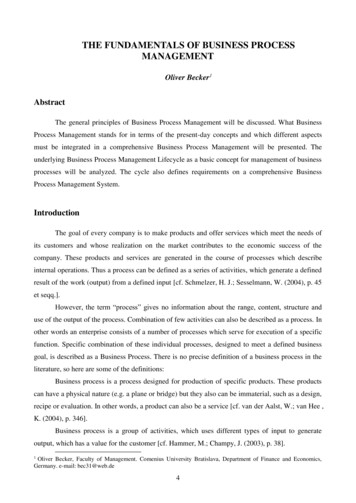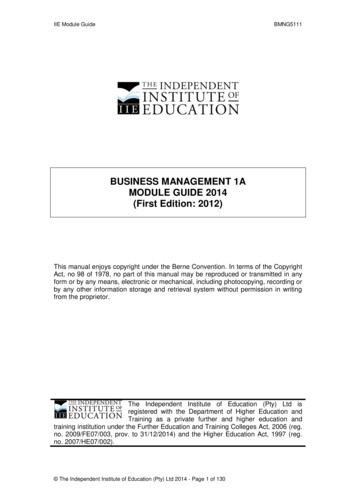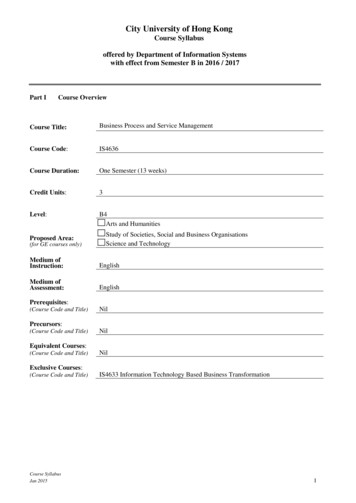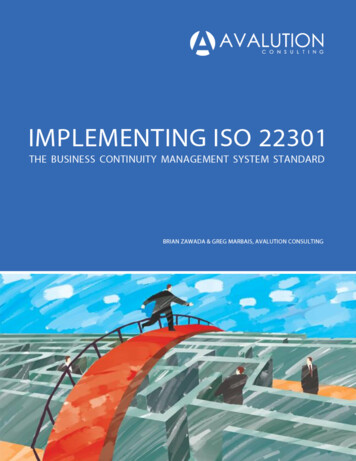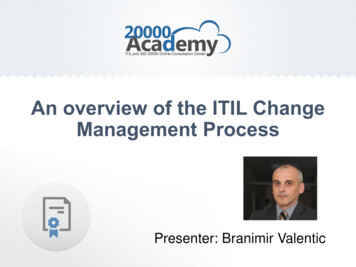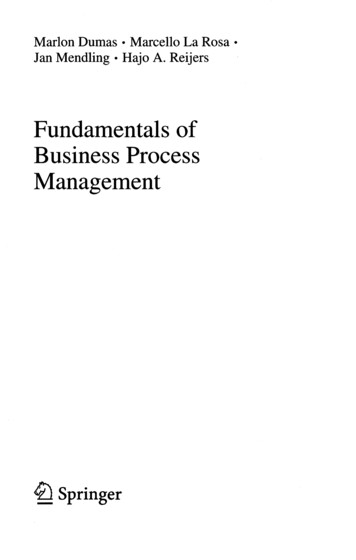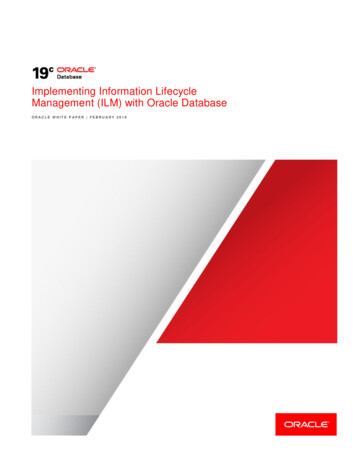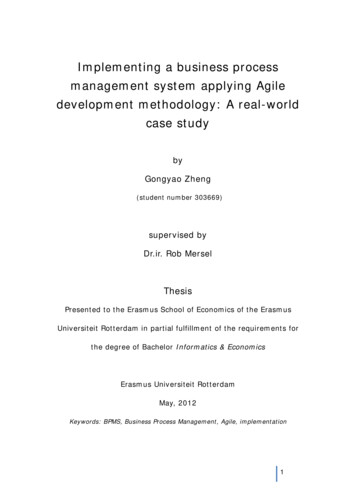
Transcription
Implementing a business processmanagement system applying Agiledevelopment methodology: A real-worldcase studybyGongyao Zheng(student number 303669)supervised byDr.ir. Rob MerselThesisPresented to the Erasmus School of Economics of the ErasmusUniversiteit Rotterdam in partial fulfillment of the requirements forthe degree of Bachelor Informatics & EconomicsErasmus Universiteit RotterdamMay, 2012Keywords: BPMS, Business Process Management, Agile, implementation1
IntroductionToday’s companies do not only need to do more than ever before, they needto do it all faster and better, preferably with lower costs and higher ROI.Furthermore, in order to preserve the competitive advantage and to face thequickly increasing global competition, “companies must continuouslyimplement the best practice management principles, strategies andtechnologies” (Carpinetti et al.,2003).One of the best practicemanagement principles is Business Process Management (BPM) (Kilmann,1995).Business Process Management (BPM) is an approach to improve and tooptimize business processes, aiming to contribute company's enterprisevalue and performance. The concept of using business processes to improveefficiencies and effectiveness of an organization has been around for a longtime (Pritchard & Armistead, 1999), BPM becomes “a boundary lessapproach to modern competitiveness” (Zairi, 1997).According to historicalresearches, “a prerequisite for managing an organization based on itsprocesses is to know which business processes are performed within theorganization and how they are related to each other. Hence, aprocess-oriented firm explicitly designs and documents its businessprocesses” (processorientation.com, 2009). For this reason, the companiesare improving and controlling processes more seriously.With such a setting, the largest drinking water company in the NetherlandsVitens n.v. started in 2008 a series of BPM programs designed to turn thecompany from a traditional department-based company into a modernprocess-oriented company. One of projects is to implement a BPMS(business process management system) for its core process CustomerRegistration. This project describes, analyzes, improves and automates the2
process of Vitens, aims to ensure optimization of processes and help tosetting up a process-oriented organization.With a traditional BPM project, the skills and development needed toimplement limits the ability to respond quickly to changes (Simmons et al.,2012). Pair this with a gap/delay between business and ilyresultofintheloosecollaboration, extended development time and budget surplus.Within the project, an approach called Agile development methodology isapplied intent on shifting up development cycle and tightening upcollaboration between participants. The objective of this paper is to examinehow far the Agile development methodology may serve as a propermethodological approach in a complex BPM implementation project byanalyzing the implementation of the whole project and the impact on theorganization. It is hoped that the study can reveal some of the major velopmentmethodology.In this paper, I start presenting some background of Business ProcessManagement (BPM) and explain why BPM should be applied. After that, anintroduction is given about the Agile development methodology to explain itskey elements in detail. In the following, continuing in my paper I describethe project environment. And it follows by a detailed, phased approachanalysis for implementing the BPMS project. Finally, I point out some lessonslearned which are found in the project regarding the approach and concludewith a summary.3
Table of contentIntroduction. 2Table of content . 4Research methodology . 6Research type and strategy .6Research scope.6Research question .7Business Process Management (System). 8The Agile methodology. 10Approaches to BPM.10The Agile methodology .11Scrum.12Team.12Testing .13Iterations .13BPM cycle.14Success criteria of Agile project .14Project . 16Company .16Objective BPMS project.16Scope.17As-is (previous situation).19To-Be (desired situation ) .20Process teams.21Development cycle.22Testing .24Communication.26Conclusions . 29Project outcomes .29Suitability.32Drawbacks of Agile methodology.344
Conclusion.37References . 38Appendix. 435
Research methodologyResearch type and strategyThis chapter of research methodology will present the whole researchprocess of the thesis. A descriptive research method will be adopted todescribe and analyze the design and the implementation of the BPMS projectby applying the Agile development methodology.Despite that secondary research is normally used in a descriptive researchto collate and synthesize existing researches, in this paper, the primaryresearch provide main data for analysis through direct observation andinvolvement in the project, some project participants will be interviewed andinformation of project evaluation at the end of the project will also be useful.Some researchers (Flyvbjerg, 2006) argue that “qualitative methods andcase study research may be used both for hypotheses-testing and forgeneralizing beyond the particular cases studied”. In this context, a casestudy of a BPMS implementation project of a specific business process in autilities industry will be defined as the research strategy. In addition,qualitative research will be used in the research which is “one of the mostcommon methods of performing qualitative analysis in the field” (Orlikowski& Baroudim 1991; Alavi & Carlson 1992), intends to illustrate in-depthreasons of a certain phenomenon, which focus on why and how.Research scopeWhile there is more than 1 process ongoing for BPMS implementationproject inside Vitens, in this paper, the research scope is restricted to theBPMS implementation of process Customer Registration of department6
Customer & Billing. For all that, however, it still would be interesting todetermine if Agile methodology would suit the BPMS implementation ofother processes inside the Vitens. It would also be a very useful contributionto research what kinds of situational factors are critical for success Agileproject which is necessary to analyze the case on the conclusions andstatements about repeatability and generability.Research questionTo provide in-depth analysis of the case research the following researchquestion was formulated:Does Agile development methodology suit the business and IT needs ofthe Business Process Management System implementation project forVitens' core process Customer Registration?To answer this question, the following research questions were formulated: What is Business Process Management System and what kinds ofbenefits can Vitens gain by applying it? Can Agile approach be used to implement an BPMS project and what arethe characteristics of this approach? How is the project Vitens' core process Customer Registrationimplemented by using the Agile methodology?When all these research questions are answered, a conclusion can be drawnbased on findings from the project implementation by analyzing the successcriteria of Agile project. Concluding remarks will be made if and under whichcircumstances, an Agile approach to BPMS-projects can be applied for otherprocesses at Vitens and outside of Vitens.7
Business Process Management (System)The process is the basic unit of business value within an organization,processes are connected to produce customer value, they are flows toconvert inputs into outputs in such way that the resources of an organizationare used with its operations to achieve its goals.In that light processes are organizational activities which across traditionalfunctional boundaries, many organizations “have recognized the need tomove away from the traditional functionally-based approach to managingthrough a set of clearly defined customer-driven processes” (Zairi 1997),which corroborated the results of increasing attention of business ownerstowards BPMS. A recent survey of Gartner showed that the BPMS (businessprocess management suite) market size in 2009 was valued at 1.9 billiongrowing to 3.4 billion by 2014(Gartner Inc., 2011).By contrast, although the importance of BPM is widely recognized, BPMsometimes seems to have as many different meanings. Some definitionsemphasize the continuously improvement of business processes (Zairi1997), while others pay attention of using methods, techniques, andsoftware supporting business processes (Van der Aalst et al. 2003).As a synthesis, the definition of a business process management usedthroughout this paper is: an approach to improve and optimize businessprocesses continuously, aiming to contribute company's enterprise valueand performance.BPMS is "a (suite of) software application(s) that enable the ng,anduserrepresentation of business processes and rules, based on integration of8
both existing and new information systems functionality that nandVersendaal,2007).In simpler terms, BPMS is a software that supports and implements the BPMapproach.Previous researches on academic and professional journals have made somegreat contributions to the necessities of BPM(S) (Van der Aalst et al. 2003,Weske et al. 2004, Karagiannis, 1995, Ravesteyn & Versendaal, 2007). Theyargued why organizations should start BPM(S) projects and provided manybenefits of BPM(S) which could help an organization to be efficient, effectiveand capable of changing, it includes: Improve process quality Meet customers’ requirements, improve customer satisfaction Engender continuous process improvement Improve the customer experience Improve business agility Reduce process cycle time and costs Reduce inefficiencies and errors9
The Agile methodologyApproaches to BPMMany organizations have seen the benefits which BPM can provide, it mayresult in a significant advantage for the organizations applying them,however, implementation of a business process management systems(BPMS) can be complex and time-consuming. It also requires a tighteralignment and extensive collaboration between business and IT. During theimplementation project a proper methodology must be considered tosupport and to ensure that the goals can be achieved. Fortunately,literatures on business process management suggest that great efforts havebeen done in the field of methods for BPM implementation. Ravesteyn (2007)listed 21 BPM (-related) implementation methods (appendix 1) fromprofessional and academic world. One of these methods has emerged in TheAgilemethodology).When we talk about software development methods, is it easy to recognizethe waterfall model, which is a traditional approach. Traditional approachconsistsof" sallspecifications. Development then proceeds according to the plan."(Vinekar2006). Thus it often has a long development cycle. A lack ofresponsiveness to change is another issue of traditional sequentialdevelopment. Requirements often change after a project begins, andprocess owners often change their expectations for the desired processduring the project implementation phase. The developers and other10
participators need time to respond towards the changing requirements, butit takes time and can be costly, the project could hence fail to deliver on timeand on budget. If the project is going to fail, it is much better to know after1 week rather than after 3 months. Additionally, the lack of involvement ofthe users creates a gap between business and Information Technologies (IT),where business claims that IT does not understand the business processes,and conversely.Within this content, the Agile methodology is developed to overcome theweaknesses of plan-based methods of software development. Given the truenatures of BPMS project which emphasizes collaboration between IT andbusiness as well as rapid response to change, BPMS implementation projectis the ideal candidate to apply the Agile methodology.The Agile methodologyAgile software development is a framework of a group of softwaredevelopment methods for software development project management aswell as solution implementation, with principles of iterative and incrementaldevelopment, continuous testing, and frequent re-planning based oncurrent reality where requirements and solutions evolve through highlycollaboration between self-organizing, cross-functional teams.The Agile methodology favors the need for flexibility and adaptability of theorganization (Highsmith, 2002), it allows business and IT to work togetheron design in terms of desired processes which could result in a quick qualitysolution, it helps customers to achieve dramatic business results byaccelerating time-to-market (Simmons and Steele, 2012). Other benefits ofleveraging this methodology include cost savings, risk reduction, andgreater customer satisfaction by promoting a focus on customer needs11
(Ambily O.A et al., 2011). Because of the adaptability of the methodology,customers’ demands of change in plans or requirements can often berealized in the next iteration of development. Agile methodology also allowsorganizations to respond to the unpredictability of a project (Simmons andSteele, 2012). Because the design stage is not formal and developers workin short iterations, significant requirements can be changed without muchloss of productivity.There are several methods under the agile framework, some methods focuson project management and collaboration practices, while others focus onsoftware development practices. Scrum is one good example of the firstkind.ScrumScrum is a discipline used to manage project and to stimulate collaborationusing iterative, incremental practices. Within the Scrum discipline, a seriesof iterations are used as basic units in the project. In the end of one iteration,a working piece of software will be delivered and can be tested, whichgenerally results in a BPMS implementation that one iteration comprises oneor more processes of the project or one process if the project is complexenough. A key benefit of iterative development is that, a deliverabledeveloped during an iteration can be directly tested by the end users at theend of the iteration.TeamIn an Agile project, the teams are cross-functional (Boehm, 2002). Thecustomers (business) usually will join the development team, they normallytake responsibility to form the requirements of functionalities and to test thedeliverable within an iteration without to taking the existing corporate12
hierarchy of an organization into account.In addition, a face-to-face communication is preferred to written documentswithin an Agile project (Agile Manifesto, 2001),. It propagates that all teammembers should locate in the same location. Since the team size is typicallysmall, excellent team communication and team collaboration will be easilyrealized. So that a regular feedback from the end users can be given quicklyen implemented afterwards as soon as possible.TestingThe major distinction of Agile from traditional methods about testing is thattesting is handled at a different stage of the software development lifecycle.Traditional methods encourage testing after complete system developmentor after a mature part of completion. Despite that Agile also executes testingafter development, the most of testing is done directly after a minor part ofsoftware delivered during an iteration.In Agile, testing is involved and accomplished by all members of the team tovalidate the client requirements at frequent intervals. As soon as possibleone sub-process is build or any bugs are fixed, they can begin to test andgive feedback quickly. Under such a scheme, potential bugs are earlydetected and fixed, it will further help to reduce the cycle time and the costof development.IterationsSince Agile methodology promotes adaptive planning (Highsmith, 2002), aBPMS implementation project who applied Agile methodology, has oftenminimal planning. Although iterations are typically short, a full softwaredevelopment cycle is fulfilled during one iteration, including planning,13
analysis, design, coding, testing. This decreases the project risk and allowsrapid changes when it is desired.BPM cycleBottlenecksinprocessesareoften clearly identifiable but howdo we improve the current chainand transform the focus of the adhoc response to an organizationthatgoesforcontinuousoptimization? This can be done bymeans of the BPM cycle (figure 1).Figure 1: BPM cycleThis cycle is called plan-do-check-act cycle, in which a process is performedbased on a plan (with goals, coupled with the strategy of the organization).There is a regular 'check' on the basis of measurements and evaluations.When unwanted deviations are found that differ from the plan and thestrategy, an 'act' adjustments will be implemented in order to correct it.Then the cycle begins again with 'Plan' to initialize process improvement sothat the quality of the process always improves. Consequently, the BPMcycle is a learning curve within the organization in which people remaincritical and constantly look at where quality can be increased.Success criteria of Agile projectBased on existing literature, there are a number of articles describingempirical studies related to the Agile methodology. Wan and Wang (2012)verify critical success factors (CSF) in their empirical case study, whileSchatz and Abdelshafi (2005) provide results from the Primavera case study14
indicating how to measure success in an Agile project. Chow and Cao (2007)indentify 12 critical success factors of Agile software development projectsusing quantitative methods by gathering survey data from 109 Agileprojects. They define CSF’s as "the factors that must be present for the Agileproject to be successful" Chow and Cao (2007).Besides these case studies, other findings are based on quantitativeresearches. In the systematic review of Dybå and Dingsøyr (2008), theyevaluate, synthesize, and present the empirical findings on Agile softwaredevelopment. This is further detailed by Misra et al.(2009), who conductedthe CSF's into three categories: time, cost, and quality, which can berecognized as competitive criteria for software development project.In an Agile environment, it’s often difficult to measure the success sinceAgile welcomes changing requirements. However, Misra et al. (2009)proposed five criteria used to determine the success of Agile softwaredevelopment project, which the most critical success factors can becategorized into any of them: Reduced delivery schedules. Increased return on investment (ROI). Increased ability to meet with the current customer requirements. Increased flexibility to meet with the changing customer requirements. Improved business processes.These criteria summarize the three important angles of the success of Agileproject. Based on these criteria, the outcomes of the project are used tovalidate whether the project is successfully implemented adopting Agilemethodology.15
ProjectCompanyA number of mergers have resulted in Vitens being the largest drinkingwater company in the Netherlands. They supply drinking water to provincesof Friesland, Overijssel, Flevoland, Gelderland and Utrecht, as well as anumber of municipalities in Noord-Holland and Drenthe.The company has a vision (Vitens, 2012). it wants to be a leading drinkwater company delivering reliable drinking water and continuouslysupplying against lowest possible costs. In order to achieve this, it isimportant that the company has efficient processes, which ties to thebusiness process management.Objective BPMS projectThe department Customer & Billing of Vitens wants to improve the servicequality and efficiency of operations constantly resulting in better customersatisfaction and lower cost per connection of water. This is why thedepartment started in 2008 with Business Process Management (BPM) . Thisproject is a part of the roadmap for the department Customer & Billingaiming to reduce cost and to accomplish customer-oriented approach. Thisproject is aimed at analyzing and optimizing processes so that processes canbe more manageable, other strategic benefits of the department wish forthrough this project follow: From functional task-oriented to process-oriented ( figure 2) Continuous improve processes and increase quality of customer contact Optimization between process and operation16
Reduce transfer times of work Multi employability (reduction of FTE)Figure 2: From functional task-oriented to process-orientedScopeThe goal of this project is to implement a Business Process ManagementSystem (BPMS) supported by a BPMS software suite named IBM BusinessProcess Manager. As described in (figure 3), the project consists of 3 phases,namely Customer Registration and Cancelation, Customers RelationshipManagement and Usage, Invoicing & Cash Collection. In this paper, we focuson the Customer Registration Process.Figure 3: Project scopeThis project is done by applying Agile methodology in which the demands/wishes, process modeling and testing are intermingled. By means of thismethodology, the business requirements and system dependencies can be17
aligned.This paper describes only one process, namely Customer Registration ofdepartment Customer & Billing of Vitens, which is one of the key processesof the BPMS implementation project. The project is initialed by departmentCustomer & Billing of Vitens aimed at analyzing and optimizing processes formore manageable processes.During the project, a process team is created. These process teammembers are the key users of the BPMS. During the project implementationphase, if the current activity or process must be adjusted, the process teammembers are those that describe, request and test the changes. They will bepart of the project to cooperate with the developers, business analysts enproject managers. When the project is completed, they are able to supportand train end-users.Some responsibilities of process teams are shown below: Analyze current processes Responsible for documentation, work instructions, KPIs, processmeasurements, etc. Initialize improvements proposals (business case) Initialize new process design (BPR) Monitor Processes Manage process documentation Communicate process changesMoreover, these process team members are responsible for testing togetherwith some future end-users. At the end of project, built functionalities will betested by them through acceptance testing. By approving the outcome ofthis test and the test underlying test scripts, the acceptance will take place.18
As-is (previous situation)The following list summarizes the issues of the previous situation insideVitens concerning business process: Business1. High labor cost to execute activity2. Inconsistency of work quality between workers3. Inaccurate prediction of work completion4. Difficult to give status reports5. Failure to effectively manage process and performance6. Informal tasks and communication (lots of paper and email)7. Incomplete or inaccurate data flow between systems8. Insufficient understanding of the performance of the process IT1. Frequent change requests to deal with exceptions in the process2. Frustration about the constant changes in business requirements3. Press to shorten the development cycle4. It is not possible to keep the speed of changeConsidering the Customer Registration Process, for example, a newcustomer with a new connection, which may involve execution oftransactions such as customer registration, creating a new connection,registration of the new customer on the newly created connection andgeneration billing document in an ERP system. In practice, these fourtransactions may be performed by four different workers from ntsdepartmentrespectively. ERP systems obviate the need for duplicate data entry,however, they never alert Department Connections that the previous activityhas been completed and it is their turn to complete the transaction when19
Customer Service has handled the call from customer. As a result workersare needed to be prompted externally (manual intervention) to accomplishthese tasks/activities assigned.An activity of a businessprocessexecutedina"non BPMS" environmentisneithervisibletoactivity owner nor to theirmanager.above,AsstatedworkersofDepartment Connectionsdo not know when workgets assigned to them tocreate a new connection,and also the priority andFigure 4: previous situationdeadline of that work.Analogously, process manager is not aware of the bottlenecks, delays,exceptions, etc, process manager thus tend to be reactive.To-Be (desired situation )Figure 5 illustrates the desired situation by using BPMS which: Automatically routes and prioritizes work Helps and guides users in making decisions Provides a standardizing of solving problems Automates some activities Offers real-time visibility and control of processesAs stated before, by identifying and documenting business process, a cleardetail of the business process could be revealed. Based on documentation20
obtained from the analysis, the Business Analyst start drawing up thedesired process diagramstogetherwithprocessteams of Vitens. With theaidofanappropriatemodeling of the businessprocesses, the essentials oftheprocessescanbeunderstood. It is ideal thatthe model of processes canbe understood as much aspossiblebythepeopleinvolved in the project, inFigure 5: desired situationparticular the business. Thiscould be achieved throughthe use of graphical representations of the process. Appendix 2 shows themodel of the desired situation for Customer Registration Process by usingBusiness Process Model and Notation (BPMN).Process teamsBy identifying process, workers will get a better insight into their work. Thisensures uniformity in the workplace and will bring problems to light easier.Moreover, since the most processes are cross-department, therefore itoffers an improved communication between different departments. The ideais that it is more efficient f
towards BPMS. A recent survey of Gartner showed that the BPMS (business process management suite) market size in 2009 was valued at 1.9 billion growing to 3.4 billion by 2014(Gartner Inc., 2011). By contrast, although the importance of BPM is widely recognized, BPM sometimes seems to have as many different meanings. Some definitions
